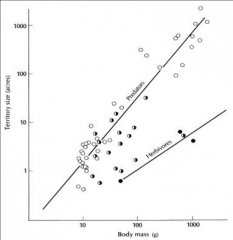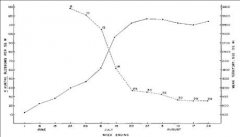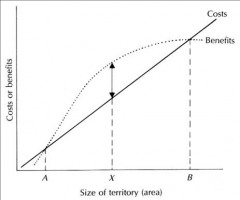![]()
![]()
![]()
Use LEFT and RIGHT arrow keys to navigate between flashcards;
Use UP and DOWN arrow keys to flip the card;
H to show hint;
A reads text to speech;
22 Cards in this Set
- Front
- Back
|
Spacing |
reduces frequency of hostile interactions and increases foraging efficiency Ex. Swallow space themselves on regular intervals on telephone wire |
|
|
Allopreening |
-mutual preening between two birds - the main purpose of which is to reduce the instinctive aggression when birds are in close contact - In the breeding season, allopreening helps to strengthen the pair bond between the male and female This behaviour is especially common in parrots |
|
|
Territoriality |
Territory = A fixed area defended continuously for some period of time – Can occur in breeding and non-breeding seasons –Often defended with elaborate display Ex. humming birds and sunbirds - defend clumps of flowers for several days to several weeks |
|

|
Territory size increases in relation to body size, energy requirements, and food habits |
|

|
Feeding territories of hummingbirds and sunbirds decrease with flower density |
|

|
Territory size is a balance of costs and benefits |
|
|
Flocks versus territories |
- Stable food resources and defensible spaces promote territoriality - Unstable food resources and indefensible areas promote flocking |
|
|
Dominance hierarchies |
- Common in birds where flock membership is stable and flock size is small - Stable hierarchies lower the frequency and intensity of overt hostility Ex. Aggressive peck rates in stable groups of domestic fowl average 1 peck / min - When group membership is changed, aggressive peck rate increases to 3 pecks / min - Dominance is associated with individual recognition |
|
|
Dominance relationships |
- are generally connected to age, size, and sex: -- Old birds usually dominate young birds -- Large birds usually dominate small birds -- Males usually dominate females - Once dominance relationships are established they tend to remain fixed |
|
|
Anti-predation advantages of flocking: |
- Distribution of predation risk
- Enhanced predator confusion - Enhanced predator detection |
|
|
Optimal Flock Size |
balance between time spent fighting other members of the flock, time spent scanning for predators, and time spent feeding |
|

|
Optimal Flock size Ex. In Yellow-eyed Juncos, flock size increased from 3.9 to 7.3 when a Harris’ Hawk flew over the feeding grounds |
|
|
Mobbing |
- When birds discover a predator, they scold them vocally and sometimes attach them physically - Advantages: discouraging or driving away an enemy -- Social learning of predator detection |
|
|
Bateman’s Principle: |
Females invest more energy in gametes, and therefore females are a limiting resource |
|
|
Mating Systems |
- Monogamy - Polygamy - Promiscuity |
|
|
Monogamy |
- Prolonged pair bond with a single member of the opposite sex for raising young (91%) - The most common avian mating strategy - Monogamy is associated with periods of mate assessment and pair formation Ex. chickadees |
|
|
Divorce |
- Abandoning a partner to pair with a new partner - Out of 49 partnerships that lasted >1 year: 38 pairs were faithful between seasons //11 pairs divorced between seasons - used as a strategy to improve mating opportunities |
|
|
Extra-pair copulations |
Controversial hypotheses for the benefit of EPCs: - Direct benefits Material benefits Fertility assurance - Indirect benefits Good genes Genetic diversity |
|
|
Polygamy |
Any mating system involving prolonged Types: 1. Polygyny - 1 male with 2 or more females (2%) Ex. Indigo bunting 2. Polyandry - 1 female with 2 or more males (<1%) Ex. Spotted sandpiper 3. Polygynandry - 1 female with 2 or more males, each with 1 or more other females (<<1%) Ex. emu |
|
|
Promiscuity |
Indiscriminant sexual relationships usually of brief duration (6%) Ex. peacock |
|
|
Leks |
- communal display ground where promiscuous males gather to display for females - are characterized by extreme reproductive skew for males |
|
|
Competing explanations for the formation of leks |
1. The Hot Spot model – Males gather at sites where they are most likely to find females 2. The Hot Shot model – Males gather near other males who are good at attracting females |

